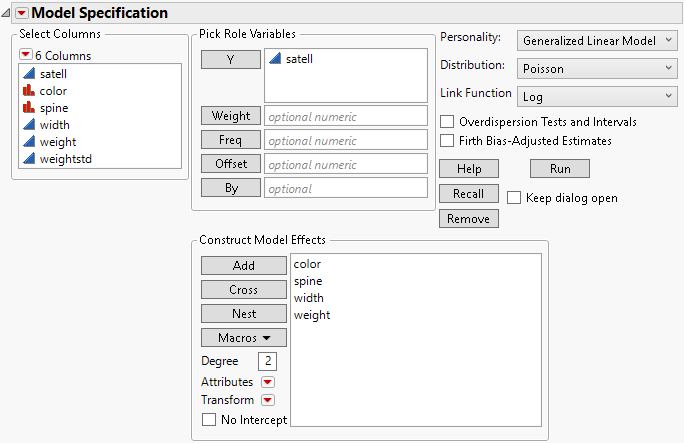Launch the Generalized Linear Model Personality
Launch the Generalized Linear Model personality by selecting Analyze > Fit Model, entering one or more columns for Y, and selecting Generalized Linear Model from the Personality menu.
Figure 12.4 Fit Model Launch Window with Generalized Linear Model Selected
For more information about aspects of the Fit Model window that are common to all personalities, see Model Specification. For more information about the options in the Select Columns red triangle menu, see Column Filter Menu in Using JMP. Information specific to the Generalized Linear Model personality is presented here.
If your model effects have missing values, you can treat these missing values as informative categories. Select the Informative Missing option from the Model Specification red triangle menu.
Tip: The No Intercept option is not available in the Generalized Linear Model personality of the Fit Model platform.
When you select Generalized Linear Model for Personality, the Fit Model launch window changes to include additional options. The following additional options are available in the Generalized Linear Model personality:
Distribution
Specifies a probability distribution for the response variable.
Link Function
Specifies a link function that relates the linear model to the response variable.
Overdispersion Tests and Intervals
Specifies that an overdispersion parameter should be included in the model. Overdispersion occurs when the variance of the response is greater than would be expected by the theoretical variance of the response distribution. This can arise in Poisson and binomial response models. McCullagh and Nelder (1989) state that overdispersion is not uncommon in practice.
Note: This option adds a column for Overdispersion to the Goodness-of-Fit Statistics table in the Whole Model Test report.
Firth Bias-Adjusted Estimates
Specifies that the Firth bias-adjusted method is used to fit the model. This maximum likelihood-based method has been shown to produce better estimates and tests than maximum likelihood-based models that do not use bias correction. In addition, bias-corrected MLEs ameliorate separation problems that tend to occur in logistic-type models. For more information about the separation problem in logistic regression, see Firth (1993) and Heinze and Schemper (2002).
Offset
(Appears as a Pick Role Variables button.) Specifies a variable for the offset. An offset variable is one that is treated like a regression covariate whose parameter is fixed to be 1.0. Offset variables are most often used to scale the modeling of the mean in Poisson regression situations with a log link.
Response Specification for the Binomial Response Distribution
When you select Binomial as the Distribution, the response variable must be specified in one of the following ways:
• If your data are not summarized as frequencies of events, specify a single binary column as the response. The response column must be nominal.
• If your data are summarized as frequencies of events, specify a single binary column as the response and a frequency variable in the Freq role. The response column must be nominal, and the frequency variable contains the count of each response level.
• If your data are summarized as frequencies of events and number of trials, specify two continuous columns in this order: a count of the number of successes, and a count of the number of trials. Alternatively, you can specify the number of failures instead of the number of successes.
